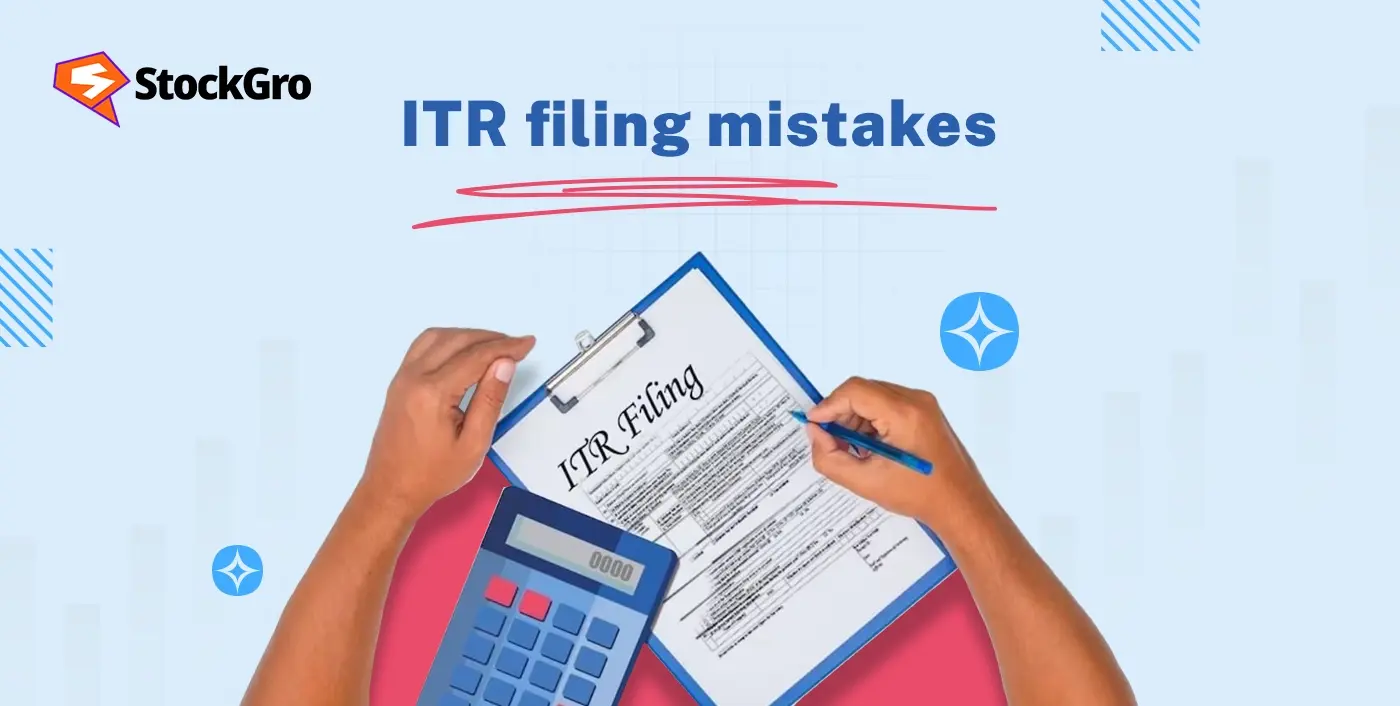
More than 9 crore income tax returns were submitted in India during FY 2024-25. This figure demonstrates that the tax filing process is undertaken by such a vast number of people every year.
Even those who are well-versed in taxes can fall into the trap of making mistakes, which might lead to financial loss, delay in refunds or unnecessary investigation. Here are five of the common mistakes while filing their ITR with the ways that you can avoid them.
Missing the filing deadline or not filing at all
It is important to prepare your income tax return on time to remain penalty-free and avoid unnecessary trouble in life. Here’s why, and what it means if you miss the deadline:
- Filing on time helps you avoid penalties, claim eligible deductions, and carry forward losses to future years. It also makes it easier to get loans and process visa applications smoothly.
- In case you file late, you may have to cough up a penalty under Section 234F of income tax act up to ₹5,000 (or ₹1,000 for those with income less than ₹5 lakh) and interest at 1% per month on the unpaid tax.
- Not filing at all can be even more severe, with loss of deductions, delayed refunds, and in extreme cases prosecution with imprisonment of up to 7 years.
Also Read: New Income Tax Bill and Tax Slabs Update
Incorrect ITR filing form selection
Selecting the correct ITR filing form is crucial, as it ensures your income, deductions, and tax liability are accurately reported by your specific financial situation. Submitting an incorrect form may result in your return labeled as “defective” or even rejected by the tax department which could delay your refund or require you to resubmit the return. It can also result in the loss of deductions your child is entitled to and scrutiny they don’t deserve.
ITR-1, ITR-2, ITR-3, AND ITR-4 are the primary forms used for filing income tax returns, each meant for specific income sources and taxpayer categories. Typical situations where the wrong form is used include:
- Salary earners declaring capital gains on ITR-1, instead of ITR-2.
- Self-employed artists, freelancers, and professionals should use ITR-3 or ITR-4, not ITR-1 or ITR-2.
- Taxpayers with foreign assets or foreign income using ITR-1 or ITR-4, instead of ITR-2 or ITR-3, which are required for such disclosures.
- Taxpayers with business income who had filed forms intended for salaried individuals.
These are some common situations where taxpayers make mistakes, which can have detrimental consequences.
Also Read: What is ITR? How to file ITR Declaration?
Incomplete or incorrect personal and income details
Entering an incorrect or incomplete PAN in the designated field can cause significant problems, making it essential to provide the correct details accurately. Such errors could result in a late refund, returned credit of a tax refund, or messages from the tax department that went unnoticed that might leave you running around in stress and hassle.
Failure to declare other sources of income is another frequent error. Income from saving interest, FDs, rent, capital gains, or freelancing often has TDS deductions and may go unnoticed during tax filing.
Underreporting of income due to your failure to declare all sources of your income can invite tax notices, penalties, and even tax scrutiny. The Income Tax Department may issue a notice under Section 133(6) for information or clarification regarding suspected underreporting, or a notice under Section 148 for reassessment if income has escaped assessment.
Not reconciling with form 26AS/AIS or failing to e-verify
The income and tax numbers mentioned in your ITR should be the same as on the Form 26AS and Annual Information Statement (AIS). All these forms which you receive at year-end show you a summary of all the taxes deducted, collected, and high-value transactions so that you can later cross-verify whether your income and tax credits are reported correctly or not. Any discrepancy can delay processing, tax notices, or worse, penalties, so always address discrepancies before you file.
So the next time you’re doing your ITR filing, you will be required to e-verify it within 30 days; otherwise, it will be deemed invalid. E-verification can be done online through Aadhaar OTP, net banking, or other methods. However, if e-verification is not done, the return will not be processed, thereby causing delay and possible penalization in terms of penalty and also making you ineligible to receive a refund.
Misreporting of deductions and exemptions
Incorrectly reporting the deductions and exemptions is a common mistake that can cause a major headache in the processing of ITR filing. Being unable to prove that you are entitled to some deductions or using supporting documents incorrectly, such as those from sections 80C, 80D, or HRA, LTA, etc., can lead to a denial of claims, a refund that is less than expected, or even fines.
Making a statement that is either too high or low or telling lies will make your return be considered as defective according to Section 139(9) or will be selected for review according to Section 143(2). If you have under-reported income, the law states that you can get a penalty of twice the amount of the tax that is due under the Section 270A(8). Besides that, if you keep making the same mistakes, you can be under closer suspicion and there may be a delay in the refund of the money to you.
Also Read: A guide to growing your income tax returns refund
Conclusion
Avoiding common mistakes when filing income tax returns can help you have a hassle-free experience. Errors like late filing, wrong ITR filed, incorrect details, mismatch with Form 26AS/AIS, or not e-verifying can lead to penalties, late fees, and tax scrutiny.
To have your return processed as fast as possible, diligently look through everything, get it started well in advance, or hire someone if you’re not sure what to do. Just a few simple precautions like these, and stay legal, avoid the headaches, and get your refund on time.
FAQs
If you are incorrect on your tax return, you may experience delays in processing or receiving your refund. Major errors, including underreporting income or improper deductions, may result in penalties, interest payments, or notices from the department. In severe cases, your return might even be rejected and you’ll be required to submit a new return. Identifying and fixing errors early on can save you additional problems and legal recourse.
To prevent errors in your ITR filing, have all the documents in hand, including Form 16, Form 26AS, bank statements, and investment proofs before filing the ITR. Carefully verify all personal information, including your PAN, bank account details, and address, and ensure that every income source is accurately reported. Validate your income information using Form 26AS/AIS to prevent discrepancies. Carefully review all entries and calculations before filing, and complete the e-verification process to ensure your return is officially recognized and effective.
Submitting false tax returns can result in serious consequences. Understating or misstating income can result in penalties of 50% to 200% of the tax due. Interest will also be levied on the outstanding tax amount. Filing false information or filing the wrong ITR form can make your return “defective” or, in other cases, rejected, which will result in disallowing deductions and delayed refunds. In the worst-case scenario, repeated or willful errors can lead to prosecution.
Some of the most common tax mistakes include
Incorrect entry of personal information such as but not limited to PAN, bank account number, or residential address, the use of the wrong ITR form, and failing to include all sources of income(such as interest or rent income).
Other common mistakes include calculation errors, denial of valid deductions, mismatch with Form 26AS, and delay or failure to file returns.
All of these mistakes can result in penalties, delayed refunds, or notice from the tax authority.
To prevent a tax mistake while filing a tax return online, always collect all the documents in advance and enter your personal information, PAN, and bank account numbers correctly. Ensure that you are using the correct ITR form and accurately disclosing all your sources of income. Compare your data with Form 26AS and AIS to identify the discrepancies. Gently double-check all the entries before filing and e-verify your return to ensure that it is correct and processed successfully.

